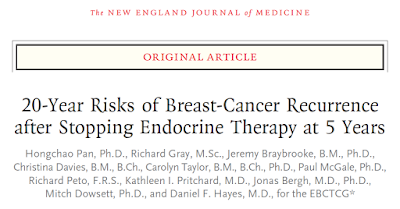ガンの生存率を学生に教えるとき極めて予後の良いがんの代表は甲状腺がんと前立腺がんであるが、その次に比較的予後の良いガンとして乳癌を紹介する。
事実国立がん研究センターが近年力をいれて発表する生存率データでも乳癌は5年でほぼ90%の生存率であり成績は良い。
一方で乳癌は5年後以降も生存率が下がり続けるガンの典型例でもある。5年目以降のフォローアップやホルモン治療の継続が議論される所以である。乳癌の10年生存率は80%に低下する。だからこその10年フォローであったはずだ。そこで私などは10年たつと「やっと卒業ですね」とこれまでは言ってきた。10年の外来通院は本当に長いから「ようやくですね、長かったですね、よく頑張りました」とねぎらってきた。
ところでこの考え方に妥当性があるのか?根拠はあるのであろうか?
頭がグラグラしてくるデータが今週号のNEJMに出ている。
題して「ホルモン治療を5年行ったあとの患者の20年後の再発リスク」というものだ。
N Engl J Med 2017; 377:1836-1846 November 9, 2017
ほぼ70000例を対象に予後をみている。死亡率ではまずリンパ節に注目すると、N0では5年で3%、10年で8%であるが、さらに15年では12%、20年では15%に上昇する。線形である。
このデータもぞっとしないが、次の遠隔転移のリスクはとみるとN0では5年で6%、10年で11%、15年では16%、20年では22%に上昇する。これもまた線形であるがこれは私には驚きのデータである。
40歳で乳癌の手術を受け「リンパ節転移がなくて良かったですね」といった患者が60歳になったとき、その5人に一人には遠隔転移(肺か肝臓あるいは脊椎であろうか??)があるというのだ。
腫瘍径を考慮しなきゃ・・・といわれるそこのあなた。層別化してみよう。
T1N0ですよね、注目したいのは。T1N0の遠隔転移のリスクはとみると10年で4%、15年では8%、20年では13%に上昇する。これもまた線形であり、さっきの例えで言うと患者が60歳になったとき、その8人に一人には遠隔転移があるというものだ。(ちなみにT2N0なら20年では19%)
さらにしつこく付属資料に食い込んでみる。T1を二分してT1a,bとT1cでみてみる。腫瘍径はT1cだと10~20mm、T1a,bでは10mm以下となる。20年死亡率はそれぞれ5%と8% 。
ついで何らかのイベント(any breast cancer event)が起こる可能性はT1a,bN0 で19%, T1cN0 で21%と高く、ついでにT2N0をみるとこれも26%であるから腫瘍が小さければ安全とは決していえない。
ちなみにこのイベントとは (distant recurrence, locoregional recurrence, or contralateral new primary tumor, regardless of unrelated deaths)のことである。
胃癌や大腸癌でT1N0に相当する患者との比較で考えると、以上の死亡率や転移発生率は深刻なものと捉えたほうが良いのではないだろうか?
N0乳癌は予後が良いというのが私の固定概念であったが、もはや信じられない。
乳癌の予後が良いというのは過去の伝説に過ぎないのではないでしょうか?
若い世代がかかる病気である。今回の報告を受けて今後は更に25年、30年、40年後の生存率、再発率が必要とされるのではないでしょうか。
Background
The
administration of endocrine therapy for 5 years substantially reduces
recurrence rates during and after treatment in women with early-stage,
estrogen-receptor (ER)–positive breast cancer. Extending such therapy
beyond 5 years offers further protection but has additional side
effects. Obtaining data on the absolute risk of subsequent distant
recurrence if therapy stops at 5 years could help determine whether to
extend treatment.
Methods
In
this meta-analysis of the results of 88 trials involving 62,923 women
with ER-positive breast cancer who were disease-free after 5 years of
scheduled endocrine therapy, we used Kaplan–Meier and Cox regression
analyses, stratified according to trial and treatment, to assess the
associations of tumor diameter and nodal status (TN), tumor grade, and
other factors with patients’ outcomes during the period from 5 to 20
years.
Results
Breast-cancer
recurrences occurred at a steady rate throughout the study period from 5
to 20 years. The risk of distant recurrence was strongly correlated
with the original TN status. Among the patients with stage T1 disease,
the risk of distant recurrence was 13% with no nodal involvement (T1N0),
20% with one to three nodes involved (T1N1–3), and 34% with four to
nine nodes involved (T1N4–9); among those with stage T2 disease, the
risks were 19% with T2N0, 26% with T2N1–3, and 41% with T2N4–9. The risk
of death from breast cancer was similarly dependent on TN status, but
the risk of contralateral breast cancer was not. Given the TN status,
the factors of tumor grade (available in 43,590 patients) and Ki-67
status (available in 7692 patients), which are strongly correlated with
each other, were of only moderate independent predictive value for
distant recurrence, but the status regarding the progesterone receptor
(in 54,115 patients) and human epidermal growth factor receptor type 2
(HER2) (in 15,418 patients in trials with no use of trastuzumab) was not
predictive. During the study period from 5 to 20 years, the absolute
risk of distant recurrence among patients with T1N0 breast cancer was
10% for low-grade disease, 13% for moderate-grade disease, and 17% for
high-grade disease; the corresponding risks of any recurrence or a
contralateral breast cancer were 17%, 22%, and 26%, respectively.
Conclusions
After
5 years of adjuvant endocrine therapy, breast-cancer recurrences
continued to occur steadily throughout the study period from 5 to 20
years. The risk of distant recurrence was strongly correlated with the
original TN status, with risks ranging from 10 to 41%, depending on TN
status and tumor grade. (Funded by Cancer Research UK and others.)







0 件のコメント:
コメントを投稿